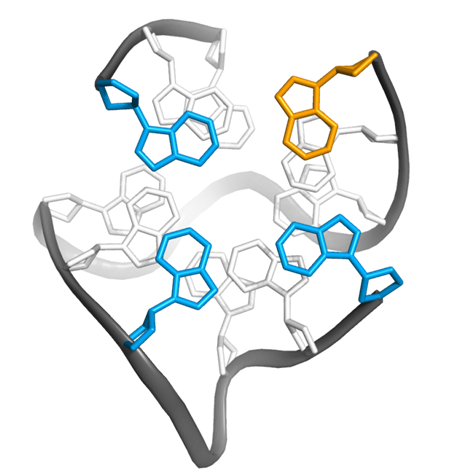Research

The G-Quadruplex: Structural Diversity and Target for Drug Design
G-Quadruplexes (G4s) have been shown to form from G-rich nucleic acid sequences. They consist of four G-tracts in which guanine bases form stacked planar tetrads stabilized by hydrogen bonding and cation coordination. Biostatistical analyses have revealed between 105 and 106 occurrences of putative G4-forming sequences in the human genome. In addition to the repetitive G-rich sequences found in single-stranded telomeric DNA, there is a significant prevalence in promoter regions of various oncogenes like c-MYC or VEGF. Indeed, recent studies have demonstrated quadruplex formation in cells, raising important questions on G4 regulatory roles in vivo.
In addition to its physiological role, the quadruplex scaffold has been shown to also constitute the basis of many nucleic acid aptamers and may also exhibit various enzymatic activities. These properties may be exploited in many different ways. Thus, various approaches have been adopted to detect proteins, nucleic acids, metabolites, or metal ions based on the unique catalytic properties of G4-derived DNAzymes.

Design of Novel Quadruplex Conformers. Depending on the outer environment and their distinct sequences, G-rich domains can fold into an amazing variety of different topologies. On the other hand, quadruplex structural transitions are often promoted by the site-specific substitution of guanosine nucleotides by analogs with particular steric or conformational features, e.g. 8-bromo-guanosine, 2‘-fluoro-riboguanosine or 2‘-fluoro-arabinoguanosine. Consequently, the structure of quadruplexes may be modified and tailored to yield novel species with unique chemical and physical properties. Major favored topologies in a given environment are often selected based on tertiary interactions between loop and overhang nucleotides, glycosidic torsion angle preferences of G residues in the quadruplex core, and by other factors like steric interactions or non-conventional hydrogen bonds. Understanding these interactions and their interplay in more detail will enable the rational design for a particular quadruplex conformation with potentially improved enzyme activity or metabolite binding.

Development of Quadruplex-Selective Ligands. Targeting quadruplex-forming sequences with selective ligands will induce or stabilize the quadruplex structure. In the following, gene expression will be modulated, making the targeting of G-quadruplexes a promising strategy for novel anticancer treatments. For their use as therapeutic agents, drugs targeting quadruplexes should exhibit high affinity but also high selectivity toward a particular quadruplex topology. In addition, quadruplex-duplex junctions are expected to widely occur under in vivo conditions, constituting novel promising structural motifs for a selective drug targeting. Clearly, first-generation ligands have to be throroughly characterized in terms of their quadruplex interactions. A complete thermodynamic profile of binding complements structural information, identifying the dominant driving forces for drug-quadruplex interactions and allowing for a more rational drug design in the future.
